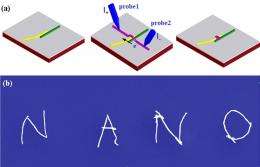December 29, 2008 feature
New 'Nanowelding' Technique for Building Electronic Nanostructures

(PhysOrg.com) -- Scientists have discovered a way to link nanowires and other nanoobjects into complex nanostructures and circuits by fusing them together with tiny amounts of solder. The researchers, from Sheffield University in the UK, expect that their method could be used to fabricate nanoelectronic test structures for research or to repair interconnects or other defects in circuits.
The process is a new form of nanowelding, which is similar to large-scale welding in that hot metal, or solder, is used to fuse the components together. The new technique may address an ongoing problem in nanotechnology research, namely the lack of successful ways to form bonds that are not only mechanically strong but can be easily tweaked to adjust the overall structure's electrical and chemical properties.
The experiment, performed by researchers Beverley Inkson, Tony Cullis, and Yong Peng, is published in the December 10, 2008, online version of Nano Letters.
In the paper, the researchers describe the nanowelding method in detail. For example, to fuse together two gold nanowires, the group positioned the wires such that their ends were touching but not their full lengths. Using a scanning electron microscope to view their work, they moved the wires with a nanomanipulator, a tiny specialized tool used in nanotechnology research to move nanostructures around, both mechanically and, by applying a current, electrically.
They laid a "sacrificial" gold nanowire across the adjacent ends and electrically severed the sacrificial wire at two points, leaving a small bridge connecting the two nanowire ends. The bridge was welded into place by applying short voltage pulses with the nanomanipulator, inducing enough heat to fuse it to the nanowires.
"The ability to weld nanowires and individual functional components is vitally important for future nanotechnology," said Inkson to PhysOrg.com. "The new nanowelding technique can be used to join nanoobjects with a wide range of shapes and chemistries, and so could be used as part of a future 3D nanoscale fabrication line.”
Inkson and her group also welded nanowires using another solder, a tin-gold alloy. This alloy is widely used in macroscopic welding because it has excellent conductivity, a low melting point, and large corrosion resistance.
The group created more complex structures and networks with the gold nanowires, including the Chinese character for "human being" and the letters "N," "A," "N," and "O." Each structure was built on a silicon wafer.
This nanowelding approach produces much better results than simply fusing together two nanowires without the use of solder, such as can be done by heating via an electric current, or "Joule heating." Currently direct Joule heating has only been successful in welding relatively large platinum nanowires as the method tends to cause significant changes in the nanowire shape, or even complete break-up of the nanowire, due to severe local over-heating.
"Using Joule heating to melt the sacrificial nanowire at the weld point, instead of fusing the nanowires directly, results in a weld that is controllable, secure, and conductive," says Inkson. “The use of nanosolder is also exciting because the chemistry and performance of the join can be engineered at the nanoscale.”
This research is published in the December 10, 2008, online edition of Nano Letters.
Citation: Nano Letters, ASAP Article, DOI:10.1021/nl8025339
Copyright 2008 PhysOrg.com.
All rights reserved. This material may not be published, broadcast, rewritten or redistributed in whole or part without the express written permission of PhysOrg.com.




















